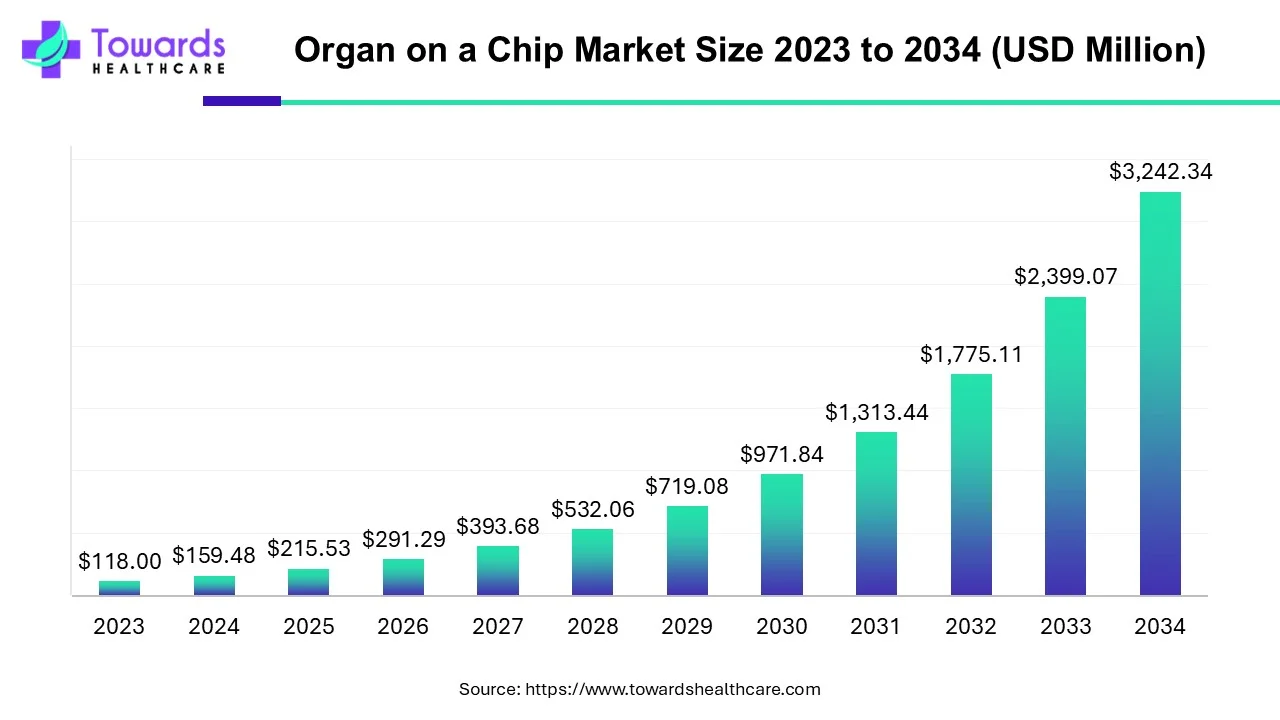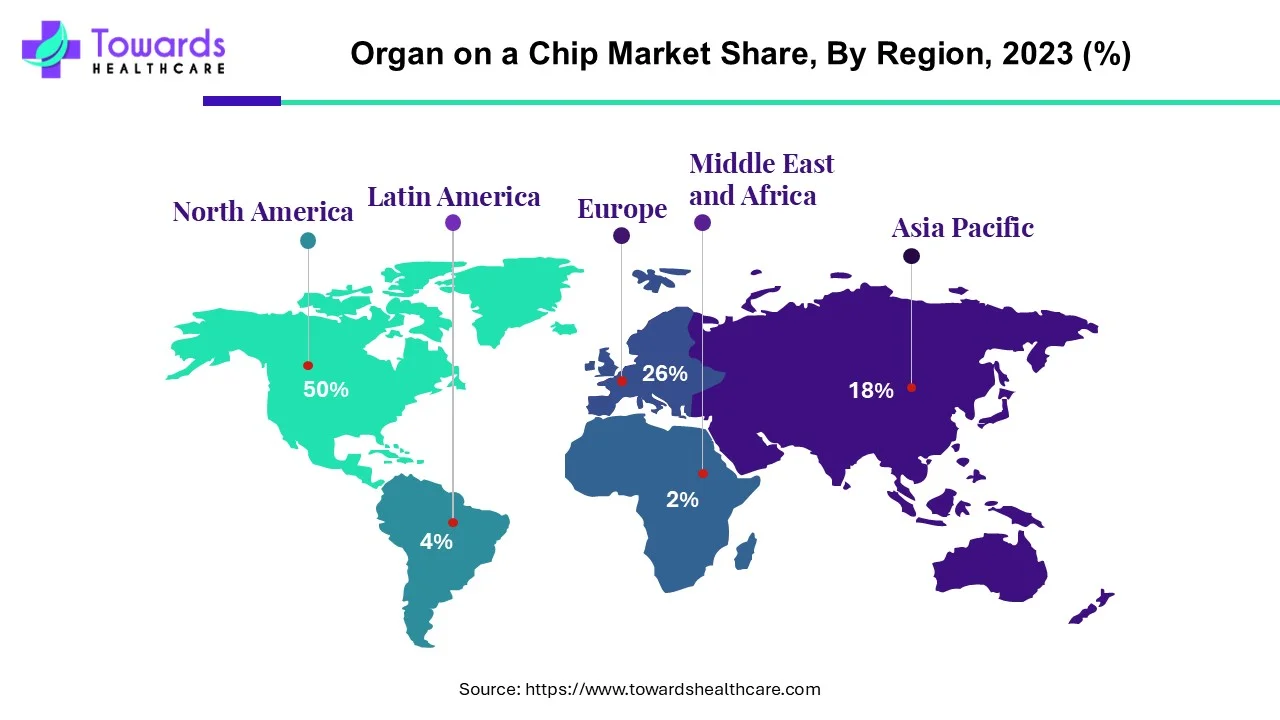December 2025

The global organ on a chip market size is calculated at US$ 159.48 million in 2024, grow to US$ 215.53 million in 2025, and is projected to reach around US$ 3242.34 million by 2034. The market is expanding at a CAGR of 35.15% between 2024 and 2034. The market is estimated to grow significantly due to growing clinical research, and investments in drug development.

Systems called organs-on-chips (OoCs) are made up of natural or artificially created tiny tissues that are cultivated inside microfluidic chips. The chips' ability to regulate cell microenvironments and preserve tissue-specific functions helps them more closely resemble human physiology. By combining the latest developments in tissue engineering and microfabrication, OoCs have drawn attention as a cutting-edge experimental platform for studying human pathophysiology and the physiological effects of treatments.
By evaluating the vast volumes of data produced by organ-on-a-chip systems and offering insights that would be challenging to gain via manual techniques, artificial intelligence (AI) can play a crucial role in these systems. To evaluate pictures of cells and tissues on the chips, forecast cellular behavior, and spot patterns and trends in the data, artificial intelligence (AI) techniques, including machine learning, deep learning, and computer vision, can be applied. The analysis of complicated biological data produced by OOC systems has been significantly improved by the integration of ML and AI in healthcare. Predictive modeling is made easier by these technologies, which speeds up drug discovery and makes it possible for researchers to more effectively detect possible dangers and advantages.
3D Bioprinting
An innovative technique that has made it possible to create complex organ structures for use in organ-on-a-chip models is 3D bioprinting. Researchers are now closer to simulating human physiological reactions in a controlled setting thanks to this development, which improves organ simulation accuracy.
Regulatory Challenges
It becomes increasingly important to navigate the regulatory environment as organ-on-a-chip technology gets more widely used. Although it is still difficult to ensure that these creative alternatives satisfy strict legal requirements, industry players and regulatory agencies are working together to solve this issue.
Increasing Collaboration
Pharmaceutical corporations, biotechnology companies, and research institutes are anticipated to collaborate more in the future of the organ on a chip market. A more thorough understanding of drug reactions may be fostered and standardized organ-on-a-chip models can be developed more quickly through collaborative efforts.
By products & services, the services segment held the largest share of the organ on a chip market in 2023. A range of products and services pertaining to Organ-on-a-Chip technology are included in the Orchestration Services Portfolio. A range of services and solutions designed specifically for drug research and discovery are probably included in this portfolio. A more accurate testing environment for possible medication candidates may be provided by these services, which may entail the utilization of microscale equipment that mimics the physiological circumstances of human organs. The portfolio could showcase various organ models, the service provider's testing skills, and their experience. All things considered, it offers a thorough overview of the variety of organ-on-a-chip services that customers in the research and pharmaceutical sectors can choose from.
By products & services, the products segment is estimated to grow at the fastest rate in the organ on a chip market during the forecast period. The structure and physiological processes of organs and human tissues may be replicated using organ-on-a-chip technologies, which are innovative microfluidic chips. The field of study has expanded thanks to this technology, also referred to as "Micro-Physiological Systems," which has improved the understanding of human biology and illness. Through the use of organ-on-a-chip technologies, scientists may investigate medication transport and tissue engineering methods as well as illnesses at a small scale.
By application, the drug discovery segment dominated the organ on a chip market in 2023. In the pharmaceutical business, new medications are constantly being created to address pressing unmet needs in many therapeutic areas. There is increasing pressure on new drug creation to meet the needs of many different sectors, particularly the pharmaceutical and healthcare industries. Prior to human clinical trials, a critical component of drug development, the evaluation of a medicine's safety and efficacy warrants more attention in order to cut down on the time and expense of drug discovery.
By application, the toxicology segment is expected to grow at the fastest rate in the organ on a chip market during the predicted period of 2024-2034. Organs-on-chips (OoCs), which are 3D cultures of heterotypic cells with suitable extracellular matrices, will be used in the next generation of chemical toxicity testing to more closely mimic the cellular milieu found in vivo. The validity of OoCs as a predictor of human toxicity is already being investigated.
By end-use, the pharmaceutical & biotechnology companies segment dominated the organ on a chip market in 2023. In recent years, a large number of businesses have developed to develop and market organ-on-a-chip technology, such as MIMETAS, InSphero, and TARA Biosystems. These companies have developed a range of organ-on-a-chip models for use in toxicity testing, disease research, and medication development, among other purposes.
By end-use, the academic & research institutes segment is anticipated to grow at the fastest CAGR in the organ on a chip market during the forecast period. Through the provision of a biomimetic in vitro, the human-like environment where cells and tissues may be investigated in settings that are almost identical to their original state with microfluidic flow, organ-on-a-chip (OoC) technology has completely transformed biomedical research. In scholarly investigations and a growing number of industrial contexts, OoC has established itself as a reliable substitute for traditional screening techniques. OoC, which was created in scholarly study, has undoubtedly produced a number of exceptional outcomes.

North America dominated the organ on a chip market by 50% in 2023. Significant elements that contribute to the region's dominance in this field include the existence of multiple businesses (with varying backgrounds in organ-on-chips, plate, technology, and model research and development), the increase in chronic disease prevalence, improved industrial efforts for drug research, and more public and private funding in the field.
The world's greatest public sponsor of biomedical research is the National Institutes of Health. The majority of the NIH's around $48 billion funding goes toward medical research aimed at improving life and lowering rates of disease and disability. Research financed by the NIH has produced discoveries and new therapies that have improved people's health and length of life while also laying the groundwork for future research.
Asia Pacific is estimated to grow at the fastest rate during the forecast period. Countries like China, South Korea, Japan, and Singapore, in particular, have been investing heavily in research and innovative inventions, which promotes the growth of the organ on a chip market in Asia Pacific. The pharmaceutical industry is the one with the quickest rate of growth due to the growing demand for customized medications, advancements in healthcare infrastructure, and the widespread availability of pharmaceutical products.
China has taken a major step toward promoting the standardized and regulated development of scientific research and industrial applications in the field of organ-on-a-chip technology with the recent release of the first national standard in the field, the skin-on-a-chip standard. The technique might be a useful tool for drug screening, toxicological testing, and cosmetics evaluation.
By 2030, India's biotech industry is expected to have grown from USD 10 billion in 2014 to USD 300 billion, a remarkable 30-fold rise. All parties must, however, be interested, proactive, and willing to contribute in order to accomplish this. The BioE3 policy and the Bio-RIDE plan are two recent government initiatives that aim to address the history of neglect in the biotech industry, which includes a lack of capital, infrastructure, and scalability.

In November 2024, by establishing its first national guidelines for "organ-on-a-chip technology," China hopes to become the world leader in a promising biotech field. The chips are a new research tool that has the potential to expedite the time it takes for a medicine to get from concept to market and replace animal testing. According to a statement released online by the Institute of Biomedical Devices in Suzhou, this milestone represents a significant advancement for China in the area of organ-on-a-chip standards.
By Products & Services
By Application
By End-Use
By Region
December 2025
December 2025
December 2025
December 2025